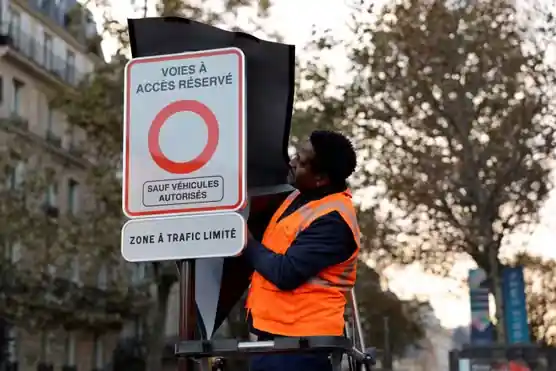Paris has officially inaugurated its first-ever Limited Traffic Zone (LTZ) as part of a broader effort to reduce congestion and protect the heart of the city.
The new system, which went into effect on November 5, bans most motorized vehicles from entering a designated area in central Paris unless they have a legitimate reason to be there.
This marks a significant shift in how the city manages its traffic flow and is part of Mayor Anne Hidalgo’s ongoing efforts to combat pollution and improve the quality of life for residents and tourists alike.
The unveiling of the new traffic signs took place at 5 pm on Monday, November 4, at a key intersection near the Place de la Bastille. As a man in a fluorescent vest climbed a stepladder to remove the cover from a sign, it revealed a red circle on a white rectangle, symbolizing the entry point into the LTZ.
This moment was not just symbolic but marked the beginning of a shift in how Parisians and visitors will experience the city’s core.
Ariel Weil, the Socialist mayor of Paris Centre, stood proudly alongside several of Mayor Hidalgo’s deputies as he explained the rationale behind the new system.
“This is the first LTZ in Paris, but not the first in France, nor in Europe. Italy has done it, and now it’s our turn. We no longer want the center of the capital to be a shortcut to travel across France and Europe,” he said.
The LTZ will cover Paris Centre, excluding the islands of Île Saint-Louis and Île de la Cité, and aims to curb the use of central Paris as a thoroughfare for non-local traffic.
The city has installed around 100 new signs marking the boundaries of the LTZ. In addition to the signs indicating entry, there will be additional signs warning drivers and motorcyclists as they approach the zone and informing them when they are leaving it.
This is part of a broader initiative to reclaim public space from cars, making it more accessible to pedestrians and cyclists.
While the move has been widely praised for its environmental and health benefits, it has also sparked opposition.
Critics, particularly from the right-wing opposition group Changer Paris, argue that the LTZ will have little environmental impact and could harm local businesses.
“It’s the eviction of Parisians in favor of tourists,” they claimed, highlighting concerns over potential disruptions to commerce.
The concept of Limited Traffic Zones is not new. European cities like Rome, Milan, and Genoa have long employed similar systems to protect their historic centers.
According to the Environment and Energy Management Agency (ADEME), there were 238 LTZs across eight European countries by 2019, with Italy leading the way. In France, cities like Nantes and Grenoble have also implemented their own LTZs in recent years.
While the Paris initiative may be seen as a model for other French cities, it is part of a wider trend of urban centers adopting measures to reduce pollution and traffic congestion.
With the LTZ now in place, the French capital is taking a bold step toward prioritizing pedestrians, cyclists, and public transport, ultimately reshaping the way people move through one of the world’s most iconic cities.



